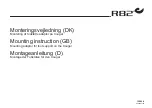
22
RX Kidz
Issue 2
Chair features
Fig. 26
Quick-release axles
To remove quick-release axles
(Fig. 26) simply press the quick-
release button (1) which is located
in the wheel hub (2), and grip the
wheel through the spokes (3)
around the hub and pull the axle
out of its sleeve (4). To replace,
slide the axle into the sleeve until
the release button ‘pops’ out and
the two locking pins (5) are visible
on the inside (6) of the sleeve.
Warning:
The axle is not secure until the
outside quick-release button pops
out to its fully extended position,
and the locking pins (5) on the
inside of the axle are in the locked
position.
3
2
1
6
4
5
Fig. 25
Backrest
The backrest is available in three
height ranges with 50mm
(2")
height adjustment in each range
(Fig. 25). The upholstery comes
with front and rear insert slots. The
rear slot (with no opening)
accommodates a standard back.
The front slot (with top opening) is
used for push handle backs.
Summary of Contents for Quickie RX Kidz
Page 1: ...Owner s Manual RX Kidz...
Page 2: ...47 RX Kidz Issue 2...
















































